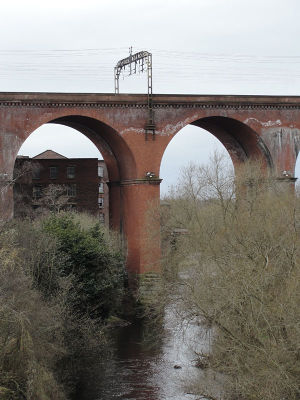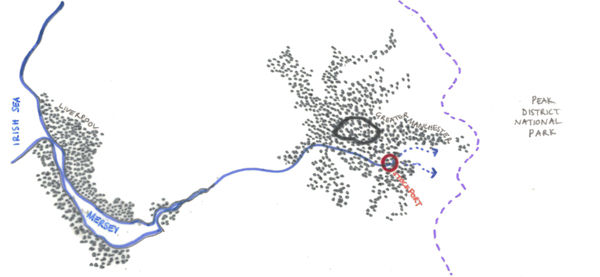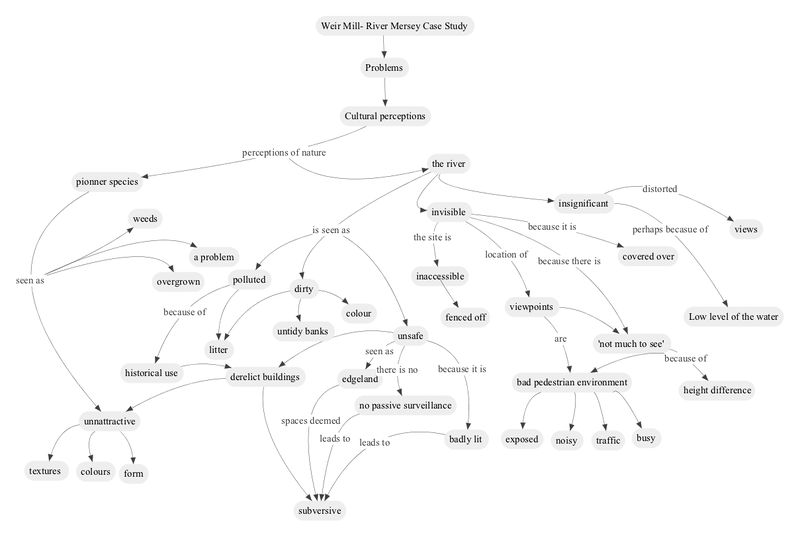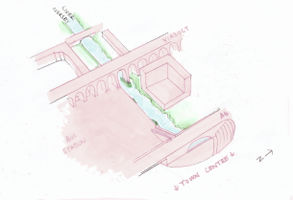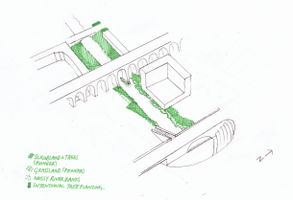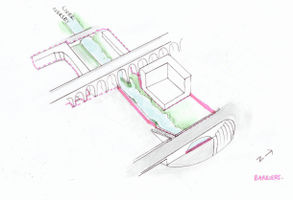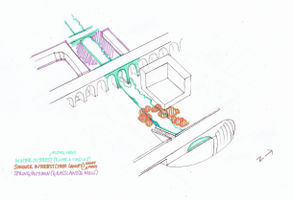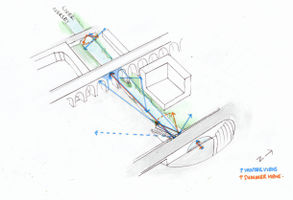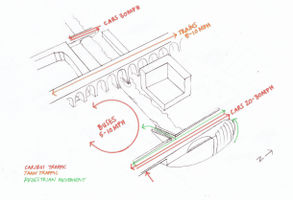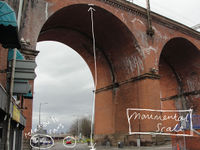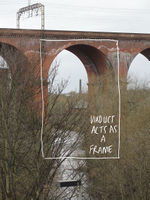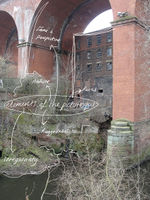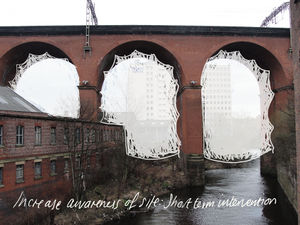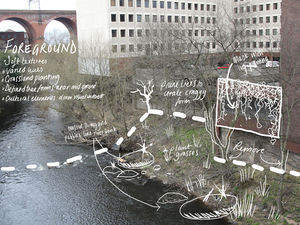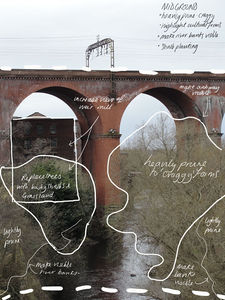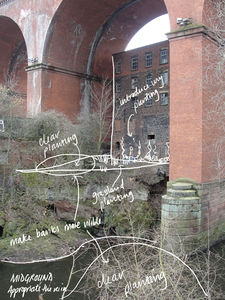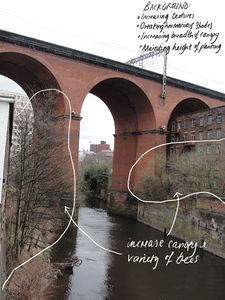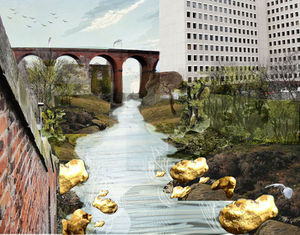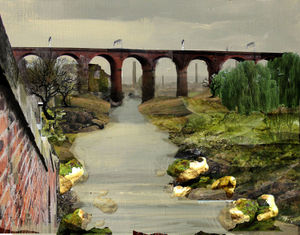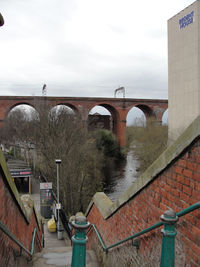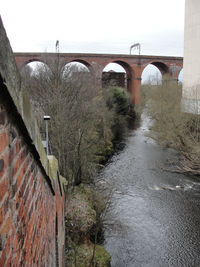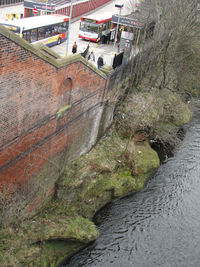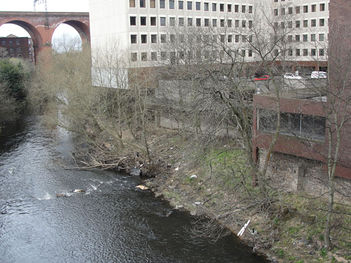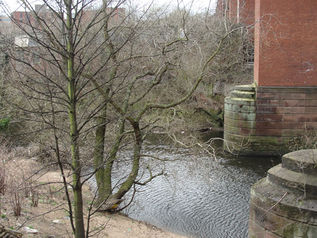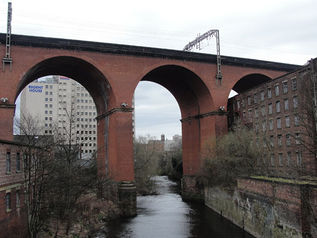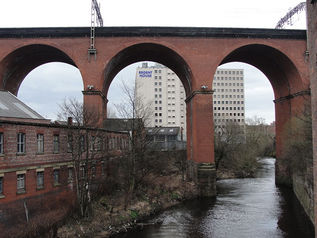Planting Design 2013 Working Group 25 - Case Study B
---> back to group page working group 25
Weir Mill, Stockport Case Study
Rationale: Why is this case interesting?
A number of strong cultural and natural elements intersect on the site of the Weir Mill along the River Mersey; the most dominant being the 19th Century viaduct, and the river bed. These interwoven elements have symbolised the shifting attitudes to nature in England throughout the past 300 years. Throughout this time, the site has been repeatedly painted by artists, a collection of these can be found using this link: [1]. The site is located in the town centre of Stockport yet is largely fenced off (a typical treatment of rivers in de-industrialised towns), the space also has complex level changes that are partly natural and partly man-made making the site an interesting case to study.
Author's perspective
My work as a landscape architecture student, practitioner and tutor demonstrates a historical approach to urban landscape research. As my practice has developed it has become increasingly influenced by cultural geography. My PhD looks at the symbolic landscape of the Northern English industrial town; interrogating the creation, recreation and reinforcement of cultural identity through built form.
Northern industrial towns have been largely overlooked by academic research despite supporting large populations and experiencing extensive urban changes. The site of the River Mersey in Stockport can be seen as a manifestation of the changing relationship between man and nature in England. The research is greatly strengthened by the portrayal of the site in art, literature and social commentary, creating a richly layered case to study.
Research Interests: Industrial towns / Northern Landscapes / Modernist Landscapes / Urbanism /
Landscape & Urban Context
Sketch of landscape and urban context
Stockport lies six miles south of Manchester, it is situated between a variety of landscape types: The Pennines (the central mountainous moorland of England), the Cheshire plain (primarily hedgerow enclosed pasture land), and the historic cotton region of Lancashire. Each of these landscape types converge at the town of Stockport.
The topography of the town is unique and defines the character of Stockport, a series of sandstone cliffs run through the town centre forming the valley of the River Mersey. Baines and Parson in 1825 explained: ‘The town stretches along the south bank of the river in the form of a large amphitheatre and the manufactories, rising in tiers above each other, when lighted with the brilliant gaseous vapour of modern discovery, present in the evenings of winter months a towering illumination of imposing grandeur.’ ibid:721. This quote highlights elements of the industrial sublime* that has dominated the character of Stockport since the industrial revolution.
A number of manmade tunnels have been made in the sandstone of the river banks, some dating as far back as the late 17th Century, but mostly having been created for the riverside manufactories throughout the industrial period. Having been re-appropriated by nature these abandoned caves and tunnels are now host to intricate micro-ecologies and climates. The river banks have been colonised by pioneer species such as Chamerion angustifolium, Buddleja davidii and Ulex europaeus.
*The industrial sublime here references Klingender's interpretation of Edmund Burke's (18th Century) Sublime philosophy 'Burke considers the sublime to be productive of the strongest emotion the mind is capable of feeling. It is associated with the infinitely great, and with gloom and obscurity…Vacuity, darkness, solitude and silence evoke the sublime, the noise of vast cataracts, raging storms, thunder or artillery and bitter tastes and ‘intolerable stenches'.' Klingender 1949:73.
Cultural History of the Site
The Mersey has a rich cultural heritage in England, it was an ancient boundary between two counties and facilitated the exponential growth of the North West region during the Industrial Revolution. The site at Stockport marked one of three natural crossings of the river and so formed the location of a Market from 1200, the crossing was instrumental in national and regional events from the Jacobite Risings of the 1700’s, to the Blanketeer’s March in 1817. In the pre-industrial period the town was likened to the Vale of Tempe the Greek scene of JMW Turner's 'Story of Apollo and Daphne'.
Defeat of Nature
The topography of the valley created a natural boundary and greatly limited north-south movement. The viaduct on site represents the defeat of this valley system symbolising a great leap in cultural attitudes towards nature as industrialists developed ways to control and tame nature. The river banks were industrialised from 1700 onwards and subsequently became heavily polluted. Freidrich Engels while surveying the condition of the working class in England stated of the site ‘…one of the duskiest, smokiest holes, and looks, indeed, especially when viewed from the viaduct, excessively repellent’ Engels 1845:43. By the 1930's the river had been covered over by a road; a shopping mall in the 1960's; and two car parks in the 1990's. Now most people do not realise a river runs through the town.
Paul Morley has recently written about Stockport: 'it had been taken for all it was worth, all its local facilities and resources drained, its natural energy squeezed and shaken until there was nothing left, used, abused, coated in filth and sundry deposits, and left if not to rot then to fend for itself.' Morley, 2013:77.
Reappropriation
The river is overgrown, inaccessible, and unnoticed despite having undergone a cleaning program in the Mersey Basin Campaign, 1985-2010. The mill which stands under the viaduct, Weir Mill, is the oldest remaining industrial building in Stockport, dating to 1790 (Arrowsmith 1997:130) and is now largely derelict. The site is at the intersection of historic and contemporary transport corridors; from a Roman road connecting Manchester and Buxton; to the 19th Century Manchester-London railway line; the 20th century M60 Manchester's orbital motorway; the A6 a national road connecting London to Carlisle; and the flight path for Manchester International Airport.
Wray has described: ‘The old town occupied the valley bottom together with the steep slopes leading up to the market place and to the medieval church, where the tumble roofs and dizzying drops in level are best seen from the iron bridge that crosses little under bank and from the great railway viaduct with its giant brick arches that stride across the valley high above the water level. Yet the river which gave form to this distinctive topography is neglected.’ ibid 2007:29.
Current Cultural Perceptions of the Site
Analytical drawings
A simplified axonometric diagram is used to sketch out the analysis, this will hopefully communicate the level differences and show the strong relationship between vertical and horizontal elements on the site.
- Analytical Drawings
Analysis of the site has shown the linear structure of the cultural and natural elements, which so far, are working against each other. Cultural elements dominate the south bank of the river and create North-South linkages across the site. Natural elements work from east to west and dominate the lowest levels of the site. The North bank of the river can be seen to have the most natural topography. Physical barriers surround the site, access is not currently available. Views into the site change throughout the seasons due to growth and decline of foliage of the scrub plants, this creates a dynamic viewpoint from the A6 - views are blocked during the summer by the trees on the river banks, long views can be seen through the viaduct and bridges throughout the winter.
Opportunities
As shown in the analysis, the site has no access to the river. This is an important aspect to maintain; as the drastic fluctuations in the water level; the fast current; and the presence of many weirs means the river banks are very dangerous and will continue to be so in the future. Rather than opening the river banks to people, the design aims to highlight the presence of a river in the town centre. As the concept has become increasingly dependent on views rather than usage, coupled with the framing aspect of the viaduct the idea of the Picturesque became increasingly intriguing. To William Gilpin the Picturesque is the composition of varied parts into one whole, he also states 'the picturesque eye abhors art; and delights solely in nature; and that as art abounds with regularity, which is only another name for smoothness; and the images of nature with irregularity, which is only another name for roughness' 1792:19.
- Opportunities
Projective drawings: Picturing the Mersey
Planting Strategy
As the picturesque values the aesthetics of a 'rough' and 'irregular' nature as an aesthetic, the planting strategy will retain 90% of the existing vegetation on site. This will be manipulated for the sake of composition through varying levels of pruning and the introduction of lower level planting through grassland species and some shrub planting. New species introduced will be taken from the indigenous species recorded on site in the 19th century (taken from Buxton 1849 and Grindon 1859) - this will create a greater level of diversity than the species currently on site; references the natural history of the site; and the botanical cultural heritage of the region; reverses the species lost as a result of industrialisation; while also referencing the dominant period of the picturesque. Species include: corydalis claviculata, viola odorata, trisetum flavescens, carex sylvatica, carex laevigata, carex muricata, ornithopus perpusillus, eupatorium cannabinum, salix alba, salix viminalis, salix helix.
Picturing the Mersey
Although the concept is focused on manipulating the aesthetics of the site it aims to have a beneficial effect in other areas too:
- Increasing the visibility of the site will connect residents to a part of their cultural heritage.
- Once people begin to see the site again, they will begin to notice the dynamic of nature and changes to the site throughout the day, week, month and seasons.
- People will be less likely to throw litter into the site.
- The manipulation of planting structures will highlight the monumentality of the viaduct, making it more of a landmark.
- Through manipulating the composition of the existing vegetation the site will retain most of its current wildlife habitats and intricacy of species.
- Increasing the textures and forms of the planting structures will introduce more diversity into the site.
- Projective Drawings
Stage Two: Defining the Foreground Stage two will increase cultural elements to create visual interest close to the viewer. Planting will be manipulated through removal of some trees, and replaced with soft textured long grasses. Shiny gold pebbles will line the river banks creating interest and making more visible the fluctuations in the level of the water, they will also help to make visible the fast pace of the river. Gold was chosen to reference the traditional colour of the frames of picturesque painting and to provide a harmonious tone between the red brick and green river banks. Gold will also be very visible against the colour of the river. Timescale: Year One.
Summary and conclusion
Please summarize your case and give arguments for your projective design (approx 150 words).
Image Gallery
</gallery>
References
Arrowsmith, Peter, Stockport (England), and Metropolitan Borough Council. 1997. Stockport: A History. [Stockport]: Stockport Metropolitan Borough Council.
Baines, Edward, and William Parson. 1825. History, Directory, and Gazetteer, of the County Palatine of Lancaster: With a Variety of Commercial & Statistical Information ... Illustrated by Maps and Plans. W. Wales & co.
Burke, Edmund. 2008 [1756] . A Philosophical Enquiry Into the Sublime and Beautiful. Routledge.
Buxton, Richard. 1849. A Botanical Guide to the Flowering Plants, Ferns, Mosses, and Algæ, Found Indigenous Within Sixteen Miles of Manchester: With Some Information as to Their Agricultural, Medicinal, and Other Uses. Longman and Company.
Copley, Stephen, and Peter Garside, ed. 1994. The Politics of the Picturesque: Literature, Landscape, and Aesthetics since 1770. Cambridge; New York: Cambridge University Press.
Engels, Friedrich. 1845. The Condition of the Working Class in England. Martino Fine Books.
Gilpin, William. 1792. Three Essays: On Picturesque Beauty; On Picturesque Travel; and On Sketching Landscape: With a Poem on Landscape Painting. T. Cadell and W. Davies.
Grindon, Leopold Hartley. 1859. The Manchester Flora.
Klingender, F. D, and Arthur Elton. 1949. Art and the Industrial Revolution. London: Paladin.
Morley, Paul. 2013. The North: (And Almost Everything In It). Bloomsbury Publishing.
Punter, David. 1994. “The Picturesque and the Sublime: Two Worldscapes.” In The Politics of the Picturesque, by Stephen Copley and Peter Garside, 220–237. Cambridge University Press.
Wray, Ian, and Colin McPherson. 2007. Mersey: The River That Changed the World. Liverpool: Bluecoat.
......................
Links to my pages:
Industrial Urbanism, PhD project Blog
Industrial Urbanism, my academic Pinterest board
About categories: You can add more categories with this tag: "", add your categories
